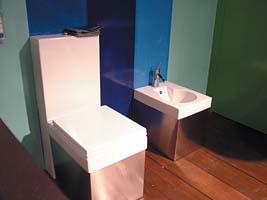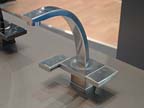
It takes a special kind of nut to get off on plumbing products. Whenever I start to feel a little strange about that, it helps to go over to Germany to meet with a couple hundred thousand crazies like me to see what's new at the biennial ISH fair. Did that again this March. Trying to describe this show to someone who hasn't been there is like trying to convey the Grand Canyon using hand shadows. The complex of buildings is categorized by product type, and just the plumbing variety alone takes up more than four of them. The overall product makeup of ISH is a little different than our U.S. shows -- it doesn't exactly parallel any of ours in that respect. It is not a kitchen product show, for instance, except in the sense of things like kitchen faucets that are part of an overall line. In Europe, you go to see kitchens at a different show. (Come to think of it, we've been seeing fewer cabinet folks at our K/BIS show than we used to.) Anyhow, that sets the stage -- let's take a walk.

General Impressions
The makeup of attendees at ISH includes a much higher percentage of installation people than we are used to seeing at our U.S. shows. These folks show a lot of enthusiastic interest in the mechanical aspects of products there. We could learn something from that.Europeans are much more influenced by "name product designers" than we are. You sense an almost cult-like following in some cases. Currently, a leading guru in this regard is Wolfgang Joop, who has designed plumbing products for a number of leading European firms. Guys like this not only create a product for you, they give you a philosophical treatise on how it was inspired and what it will do to transform your life. Makes you think that if Michelangelo was alive today, he would be sculpting toilets.
This isn't unique to Europe, but "wellness" seems to be the latest hip buzzword in the biz. While it has a more generalized meaning within certain parts of our culture today (integrating aspects of health, spirituality, etc.), in the plumbing world, it seems to relate to products with therapeutic benefits, including whirlpool, sauna and shower, and all the sensory toys that go with them these days. (Dr. Kellogg would have loved this.)
Sit down and have a beer. Many of the larger exhibitors at ISH include restaurant or pub-like areas where visitors are shown good old German hospitality. While this may seem like an extravagant use of expensive booth space, it's really a very effective way to entice visitors and have them stay and chat for a while.
Faucet Trends
Continuing: The "minimalist" look in single-lever faucets (cylindrical body with peg lever) was seen everywhere, with minor variations on the theme focusing the specifics of lever and spout form. Joystick designs (single lever with vertical handle) are growing in popularity in Europe, with the "stick" taking an even wider range of forms (many not "stick looking" at all). (Note: the joystick is not just single-lever with the handle pointing up - it is a one-plane pivoting motion rather than the traditional "lift and swing." It uses a different type of mechanism.) There were far more pre-rinse faucets for residential kitchen use this time - many versions, ranging from exact commercial units to some greatly domesticated types from the standpoint of size and utilitarian look. Large diameter "watering can" showerheads are transitioning from primarily Victorian styles to include more contemporary options. Several firms showed "soda fountain" style kitchen and bar faucets in which a single-lever or joystick control is located at the end of the spout. The following has taken a few years to gain momentum, but it's big now: faucets that install with what I would call a "flush mounting." By this, I mean that what you see is a very shallow flange with a handle immediately on top (without a vertical housing for a cartridge in-between). This was seen in both two-handle and single-lever versions. Nice, clean look.New: There was a noticeable comeback of angular faucet forms this year (squared, sharper lines), including many with cubed or triangular bases. "Radial control" is a style in which faucets have a cylindrical body with peg handle sticking out the side. These use a flow-through ceramic cartridge in which water enters at the bottom and exits through the top. Some are single-lever (with volume control) -- others cycling (turn-on-through-cold with no volume control). Because of the integration of the valving mechanism into the faucet base, this type is probably the ultimate in minimalist design. This same basic integration was seen on models in which the valving is built into the cylindrical body of tub fillers and shower arms. Cycling mechanisms were also seen on more conventional types of faucet construction (not the radial construction). There were also some new approaches to faucet actuation seen, including one that uses individual "sliding plates" to regulate hot and cold flow. In terms of materials used for faucets, there are signs of a trend in the use of solid stainless steel (not plated brass, but the real thing). For many years, plastic has not been popular for faucet handles in Europe, but the advent of joystick handles seems to have triggered a surge in this direction (translucent in many cases).
Untrend: Not many electronic faucets for residential use this time. Many attempts at such products have come and gone over the past number of shows, most of them by now in the latter category. Back in the early '90s, there seemed to be some thinking that what was needed for the home was not the automatic on & off like you get from infrared or radar systems, but rather, touchpad controls (some with memory settings). These didn't make it either. Manufacturers have told me that the idea just never caught on with the consumer -- people saw it as a novel and more expensive way to operate something that worked pretty well in its original form. Another factor: in an age where faucets are part of the decorating components of a bath, the use of an electronic gadget didn't ring anybody's bell.

Fixing Trends
General: At the same time we are seeing the most extreme examples of the continuing jelly bean or egg forms in fixture design, we are also witnessing a return of angular (square-ish) geometry. There were numerous examples of this in both tub and lavatory designs at ISH this year. The use of translucent materials was on the rise, some such fixtures equipped with internal lighting. (Ever wish your lav could double as a night light?)Lavatories: There were even more examples in the "creative drain" department this year. These are alternatives to the little round hole in the bottom of the basin. Examples include slits or slots across the bottom rear of a rectangular bowl, and inserts in round or square recesses that form a "run off gap" around their perimeters. Basins are taking more innovative shapes as well, with many being more of an angular slope from front to back. There were some that had no basin at all, but rather, a flat surface to act as a "spreader" for a laminar faucet stream. It seemed to me that the trend toward vessel-style lavatories had peaked by this year's show - lots of them around, but not quite as many.
Tubs/Showers: We saw an increasing proportion of tubs using the bubble system in comparison to the conventional whirlpool approach this time. One manufacturer told me that consumers are beginning to think of these as more sanitary. There was more use of unfinished metal (not enameled) in tub construction, some involving an exterior trim (a stainless steel skirt in one case), and some forming the basic interior vessel (how about leaning back into one of those on a cold winter night?) While vessel-style lavs seemed to have tapered off, there were some examples of this form being applied to tub design (kind of a semi-recessed concept in which the top has that "sitting on a counter" look).
Toilets: In-wall tanks were even more prominent this year. Without question, these give you the cleanest look in toilet design (why hasn't this concept taken off here?). With water conservation becoming more of a concern in Europe, we are seeing more two-stage flush mechanisms.
